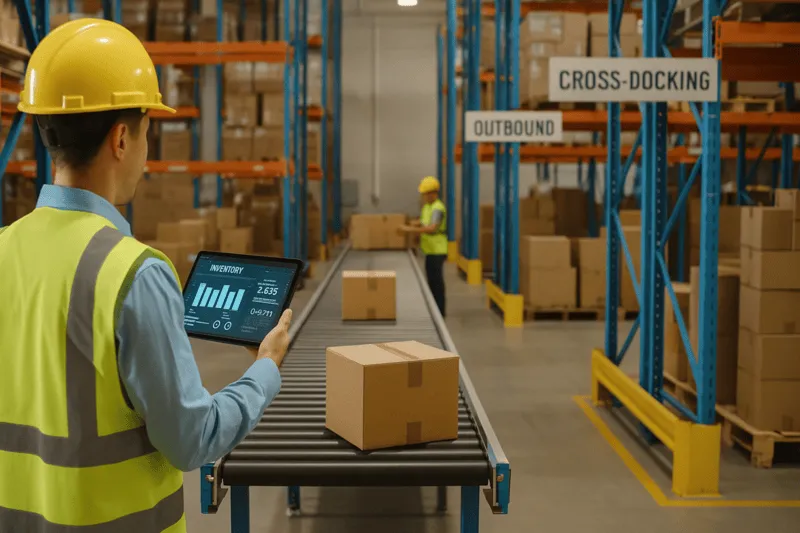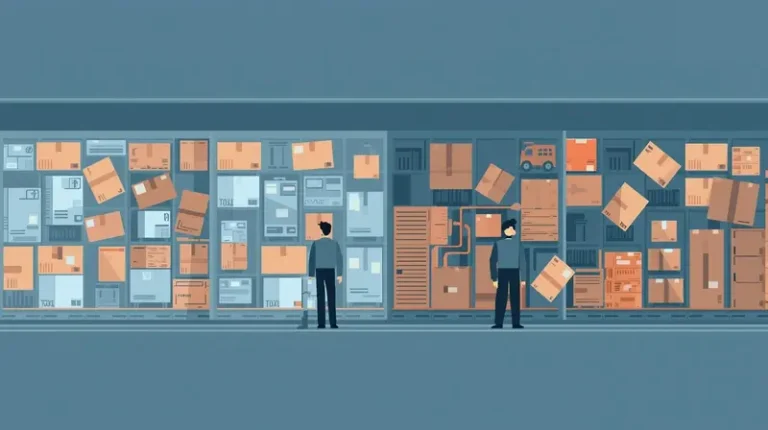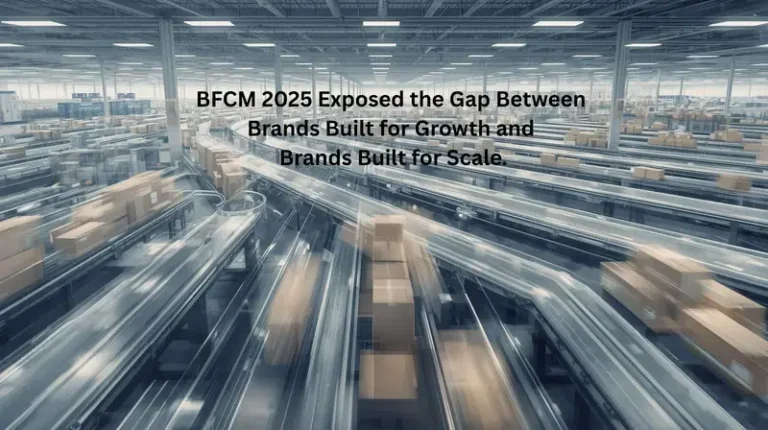Warehousing Services: How to Choose the Right Provider

Last updated on July 24, 2025

In this article
 7 minutes
7 minutes
- Warehousing Isn’t Just Storage Anymore
- Types of Warehouses: Finding the Right Fit
- What You Should Really Look For
- Technology and Automation in Modern Warehousing
- Cold Storage, Cross Docking & Specialized Services
- Returns and Reverse Logistics: Managing the Flow Back
- How Cahoot Approaches Warehousing
- Wrapping It Up
- Frequently Asked Questions
When you oversee a nationwide warehouse network like I do, you get a front-row seat to what works, and what definitely doesn’t, in modern warehousing services. The right provider can deliver a competitive advantage by streamlining logistics and reducing costs.
I’ve spent years watching ecommerce brands scale up (or burn out) based on warehouse choices. The right warehousing solutions for ecommerce businesses can boost margins and CX. The wrong one? That’ll tank both.
So, how do you choose the right provider when every one of them promises to cut costs, improve service, and handle your inventory management? Choosing wisely is the smart way to optimize warehousing services for business growth.
Warehousing Isn’t Just Storage Anymore
Ten years ago, a warehouse space was just a place to store goods, serving as a storage facility within the supply chain. Today, it’s the beating heart of your supply chain.
Smart warehouses now offer:
- Real-time inventory tracking
- Warehouse automation
- Cross-docking services
- Fast order fulfillment
- Seamless reverse logistics
- Efficient order processing
A well-organized shipping dock is also crucial for ensuring smooth inbound and outbound logistics.
But not every provider can deliver all of this with consistency. I’ve seen too many 3PLs overpromise and underdeliver.
Slash Your Fulfillment Costs by Up to 30%
Cut shipping expenses by 30% and boost profit with Cahoot's AI-optimized fulfillment services and modern tech —no overheads and no humans required!
I'm Interested in Saving Time and MoneyTypes of Warehouses: Finding the Right Fit
When it comes to optimizing your supply chain, not all warehouses are created equal. The right warehousing solutions depend on your business model, inventory management needs, and growth plans. Here’s a quick breakdown of the most common types of warehouses and how they can help you maximize efficiency:
- Private Warehouses: Owned and operated by a single company, these facilities offer complete control over warehouse operations, inventory management, and security. They’re ideal for businesses with high-volume, consistent storage needs and a desire for tailored solutions.
- Public Warehouses: These storage spaces are shared among multiple businesses, making them a cost-effective option for companies looking to reduce warehousing costs. Public warehouses provide flexible storage space and shared resources, which are perfect for businesses with fluctuating inventory levels or seasonal spikes.
- Bonded Warehouses: Specializing in imported goods, bonded warehouses allow you to store products before customs clearance. This can help businesses manage cash flow and compliance while keeping inventory secure until duties are paid.
- Distribution Warehouses: Focused on aggregating stock from various suppliers, distribution warehouses streamline wholesale deliveries and help businesses improve efficiency in their supply chain.
- Fulfillment Warehouses (3PLs): Third-party logistics providers offer a full suite of services, including inventory management, order fulfillment, and shipping. These solutions are designed for businesses that want to outsource warehouse operations and focus on scaling their core business.
By understanding the strengths of each warehouse type, you can select the solution that best fits your warehousing needs, reduce costs, and deliver a higher level of customer satisfaction.
What You Should Really Look For
From my seat, the top-performing fulfillment centers I’ve worked with share a few traits. Choosing a reliable fulfillment partner is crucial for optimizing your storage solutions, reducing costs, and improving overall supply chain efficiency.
- Operational excellence: Processes are clean, predictable, and built for continuous improvement.
- Technology-driven: If they’re not offering a warehouse management system with visibility, move on. Make sure their systems and automation are implemented correctly to ensure seamless operations and maximum efficiency.
- Strategic warehouse locations: Coverage matters more than you think, especially for fast delivery.
- Value-added services: Think kitting, bundling, or returns processing. Reliable delivery is also a critical component of customer satisfaction.
- Transparent pricing: Avoid black-box pricing models. They always cost more.
Looking for a New 3PL? Start with this Free RFP Template
Cut weeks off your selection process. Avoid pitfalls. Get the only 3PL RFP checklist built for ecommerce brands, absolutely free.
Get My Free 3PL RFPTechnology and Automation in Modern Warehousing
Modern warehousing is driven by technology and automation, transforming how businesses manage inventory, order fulfillment, and warehouse operations. Today’s smart warehouses leverage advanced warehouse management systems (WMS) to provide real-time inventory tracking and complete visibility across the supply chain. This means you can monitor inventory levels, storage space, and outbound orders from anywhere, at any time.
Warehouse automation, like robotic picking, automated conveyors, and AI-powered sorting, boosts operational excellence by reducing manual errors and labor costs. Proprietary systems, such as RyderShip and RyderShare, take it a step further by integrating real-time data, enabling businesses to make informed decisions and respond quickly to market changes.
Technologies like RFID, GPS, and IoT sensors offer real-time visibility into inventory movement and storage conditions, ensuring products are appropriately packed and stored. These innovations help businesses drive efficiencies, cut costs, and gain a competitive edge in a fast-moving market.
By embracing smart warehouses and advanced technology, businesses can optimize warehouse management, improve order fulfillment speed, and maintain complete control over their operations, no matter how complex their supply chain becomes.
Cold Storage, Cross Docking & Specialized Services
More and more brands I work with need cold storage, bonded warehouse options, or cross-dock facilities. But finding providers that can scale specialized services and still offer a competitive edge? That’s tough. In certain industries, there is also a need for dedicated storage of raw materials to support manufacturing and production processes.
This is why tailored solutions and shared resources matter. Especially if your brand has excess inventory or seasonal spikes, effective inventory control is crucial for maintaining accuracy and optimizing operations.
These specialized services not only improve efficiency but also play a key role in reducing costs for businesses.
Returns and Reverse Logistics: Managing the Flow Back
Returns and reverse logistics are no longer an afterthought; they’re a critical part of the modern supply chain. Efficient returns processing can make or break customer satisfaction, especially in ecommerce, where expectations for fast refunds and exchanges are high.
A leading provider of warehousing solutions will offer specialized services for reverse logistics, using advanced technology to streamline the flow of returned goods. Cross-docking services can minimize storage time by quickly sorting and redirecting returns, while distribution services ensure products are processed and restocked or disposed of efficiently.
By implementing robust reverse logistics systems, businesses can reduce warehousing costs, improve service levels, and gain valuable insights into product quality and customer preferences. This data-driven approach not only helps cut costs but also drives your business forward by identifying opportunities for continuous improvement.
Partnering with a provider that excels in returns management means you can maintain high customer satisfaction, optimize your supply chain management, and stay ahead in a competitive market.
Scale Faster with the World’s First Peer-to-Peer Fulfillment Network
Tap into a nationwide network of high-performance partner warehouses — expand capacity, cut shipping costs, and reach customers 1–2 days faster.
Explore Fulfillment NetworkHow Cahoot Approaches Warehousing
At Cahoot, we operate an extensive network of fulfillment centers with high standards across every node. We’re not just brokering space. We govern how that space operates, with standard SOPs, system integrations, and SLA accountability.
Our warehousing approach includes:
- Advanced technology for tracking and routing
- Support for cold storage and specialty goods
- Strategic locations near key metro hubs
- Reliable service, even during peak season
- Flexible storage solutions for different business needs
I collaborate daily with our operators to ensure everything runs like a system, not a collection of parts. Cahoot provides comprehensive warehouse solutions to address diverse supply chain challenges.
Wrapping It Up
Choosing a warehousing provider is less about how many square feet they have and more about whether they can support your long-term business’s success.
It’s also crucial to select a provider that prioritizes the needs and satisfaction of your customers, ensuring their experience is seamless and positive.
Ask hard questions. Demand transparency. And choose a partner that helps you scale smart, not just fast.
Frequently Asked Questions
What are warehousing services, and how do they support ecommerce businesses?
Warehousing services include inventory storage, order fulfillment, returns processing, and value-added services like kitting or labeling, all essential for ecommerce scalability.
What’s the difference between a shared warehouse and a dedicated warehouse?
A shared warehouse serves multiple businesses using shared resources, while a dedicated warehouse is reserved for one client, offering more control but at a higher cost.
What are the most important features to look for in a warehousing partner?
Key features include real-time inventory tracking, automation, cross-docking capabilities, temperature control, and flexible storage options.
How do warehousing services help reduce costs?
By streamlining inventory management, improving order accuracy, and using strategically located warehouses, businesses can cut transportation and storage costs.
Why choose Cahoot for warehousing services?
Cahoot’s nationwide network of fulfillment centers offers advanced tech, real-time tracking, and flexible storage, all optimized to meet ecommerce warehousing needs efficiently.

Turn Returns Into New Revenue





